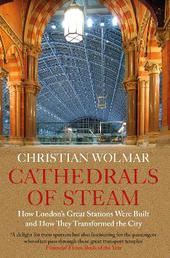
|
Cathedrals of Steam: How London's Great Stations Were Built - And How They Transformed the City
Paperback / softback
Main Details
| Title |
Cathedrals of Steam: How London's Great Stations Were Built - And How They Transformed the City
|
| Authors and Contributors |
By (author) Christian Wolmar
|
| Physical Properties |
| Format:Paperback / softback | | Pages:352 | | Dimensions(mm): Height 198,Width 129 |
|
| Category/Genre | History of architecture
British and Irish History
Industrialisation and industrial history
Trains and railways |
|---|
| ISBN/Barcode |
9781786499226
|
| Classifications | Dewey:725.3109421 |
|---|
| Audience | |
|---|
| Edition |
Main
|
| Illustrations |
1x8pp colour plates, 1x8pp b/w plates and maps
|
|
Publishing Details |
| Publisher |
Atlantic Books
|
| Imprint |
Atlantic Books
|
| Publication Date |
4 November 2021 |
| Publication Country |
United Kingdom
|
Description
'Fascinating' - 'Books of the Year', Financial Times 'London's twelve great rail termini are the epic survivors of the Victorian age... Wolmar brings them to life with the knowledge of an expert and the panache of a connoisseur.' - Simon Jenkins 'A wonderful tour, full of vivid incident and surprising detail.' - Simon Bradley London hosts twelve major railway stations, more than any other city in the world. They range from the grand and palatial, such as King's Cross and Paddington, to the modest and lesser known, such as Fenchurch Street and Cannon Street. These monuments to the age of the train are the hub of London's transport system and their development, decline and recent renewal have determined the history of the capital in many ways. Built between 1836 and 1899 by competing private train companies seeking to outdo one another, the construction of these terminuses caused tremendous upheaval and had a widespread impact on their local surroundings. What were once called 'slums' were demolished, green spaces and cemeteries were concreted over, and vast marshalling yards, engine sheds and carriage depots sprung up in their place. In a compelling and dramatic narrative, Christian Wolmar traces the development of these magnificent cathedrals of steam, provides unique insights into their history, with many entertaining anecdotes, and celebrates the recent transformation of several of these stations into wonderful blends of the old and the new.
Author Biography
Christian Wolmar has written for every national newspaper and appears frequently on TV and radio as a commentator on transport issues. His previous books include the widely-acclaimed The Subterranean Railway; Fire and Steam; Blood, Iron and Gold; Engines of War; The Great Railway Revolution; To the Edge of the World; and Railways and the Raj.
ReviewsWolmar's history will delight train spotters but is also fascinating for the passengers who often pass through these great transport temples without a second thought. * 'Books of the Year', Financial Times * Lively... Wolmar builds a compelling narrative that celebrates these industrial wonders - and teases at how much better spent some of that Victorian money might have been. * The Times * London's twelve great rail termini are the epic survivors of the Victorian age. They are the cathedrals of transportation. Wolmar brings them to life with the knowledge of an expert and the panache of a connoisseur. His words render them indestructible. -- Simon Jenkins A wonderful tour, full of vivid incident and surprising detail. Station by station, it also adds up to a portrait of London through the railway age and into our own time. -- Simon Bradley Wolmar compellingly describes how engineers and architects creating terminus stations harked back to classical or Gothic styles. But, with the advantage of iron and glass, they could erect giant structures in months not centuries, whose scale justified the description "cathedrals of steam". -- Michael Portillo Every London commuter should read this book... Fascinating histories abound from Queen Victoria's specially arranged signals to the driver to slow down on the way from Slough to Paddington, to Thomas Hardy's job of excavating graves to make way for tracks at St Pancras. -- Tom Chesshyre In this delightful homage to the capital's mighty icons of the railway age Wolmar is a worthy successor to Betjeman. -- Michael Williams A terrific book for anyone interested, not just in London's stations, but in the development of the railway since the capital's first terminus, London Bridge, opened in 1836. * ASLEF Journal * Excellent... In a skilful fusion of practicalities and aesthetics, the author captures the essence of our experience of grand stations and also reminds us to look when we pass through or, more commonly, linger impatiently while we wait for our train's platform to be called. * New Criterion * A fascinating story of Victorian capitalist free-for-all and competition behind the development of mainline stations. * Camden New Journal * London's railway termini are a monument to Victorian taste and ingenuity, now revived and re-imagined for the 21st century. Christian Wolmar's Cathedrals of Steam is their story and London's, vividly and intimately intertwined.' * Country & Town House *
|